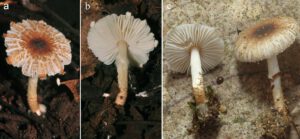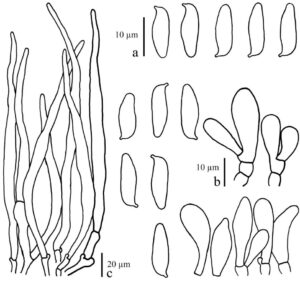Description
Pileus 30-45 mm, campanulate, expanding to convex or umbonate with small umbo, applanate with low umbo, straight margin; glabrous to rough at umbo, brown to dark brown (6E5-8, 7F7-8), with light brown to brown (7D6-8, 7E7-8) glabrous around umbo, later surface broken in radial streaks from around umbo towards margin, with concolorous tomentose to crowded squamules towards margin, on white to yellowish white (4A2) black ground; marginal zone broken, split, fringed, with white cortinate and light brown to brown (7D6-8, 7E7-8) partial veil remnants. Lamellae free, slightly crowded, ventricose to broadly, 3.0-5.0 mm wide, with 2 lenght lamellulae, white to yellowish white (4A2), with concolorous eroded edge. Stipe 35.0-45.0 × 4.0-6.0 mm, cylindrical, fibrillose or cortinate at middle zone, then with light brown to brown (7D6-8, 7E7-8) squamules downwards base, with white to yellowish white (4A2) black ground from middle to apex, with redish white (7A2) below middle zone downwards base. Annulus an annular zone, with white cortinate. Context white and up to 3 mm wide in pileus; hollow and concolorous with surface. Smell and taste unknown. Spore print white.
Basidiospores [50,2,2] 11.5-16.5 × 4.0-5.5 µm, avl × avw= 13.4 × 4.6 µm, Q= 2.80-3.0, Qav= 2.91, in side-view cylindrical amygdaliform, with attenuate apex, with straight abaxial side, with hilar appendage, with superhilar depression, in frontal view fusiform, hyaline, slightly thick-walled, dextrinoid, congophilous. Basidia 16.0-26.0 × 7.0-9.0 µm, clavate, hyaline, thick-walled, 4-spored. Cheilocystidia abundant, 27-35 × 6.5-15 µm, mostly fusiform or clavate, sometimes utriform, thick-walled, hyaline. Pileus covering a trichoderm made up of narrowly cylindrical elements, normally wider at middle and narrow to apex, with attenuate apex 70-400 × 6.0-13.5 µm, thick-walled, with brown parietal and intracellular pigment, smooth, sometimes incrusted at base of element and hyphae. Stipe covering of squamules a trichoderm similar to pileus covering. Clamp-connections present.
Habitat and distribution: Growing solitary to a small group; saprotrophic and terrestrial on humus soil; originally described from Northern Thailand (Sysouphanthong et al., 2012). This is the first report in Laos.
Material examined: Laos, Oudomxay Province, Xay District, Houay Houm Village, N 20° 32′ 00.67″, E 101° 53′ 48. 17.16″. 917 m., 10 July 2014, P. Sysouphanthong, PS2014-1460 (HNL503131); ibidem, 12 August 2014, P. Sysouphanthong, PS2014-1479 (HNL503150).
Notes: Lepiota pongduadensis is a new record from Laos; two Lao specimens were collected from Oudomxay Province of northern Laos. Lepiota pongduadensis was originally described from Chiang Mai and Chiang Rai Provinces of northern Thailand, the species is placed in sect. Lepiota, it is distinguished from other species in the section, and only few species are similar to L. pongduadensis (Sysouphanthong et al., 2012). Lepiota attenuata, the type specimens from China, is similar to L. pongduadensis by morphology, but different on lacking of dark brown surface on umbo, lighter colour of squamules on pileus and stipe covering (brownish yellow to yellowish brown), larger basidiospores (14.5–19.0 × 4.0–5.5 mm), shorter elements of pileus covering (80–231 3 8–13 mm) (Liang et al., 2011).
GenBank numbers:
ITS: MT436259, MT436260 (ITS1-F/ITS4).
Figure 1. Lepiota in habitat, a-b= HNL503131, c= HNL503150.
Figure 2. Lepiota pongduadensis (HNL503131). a= basidiospores, b= cheilocystidia, c= pileus covering.


